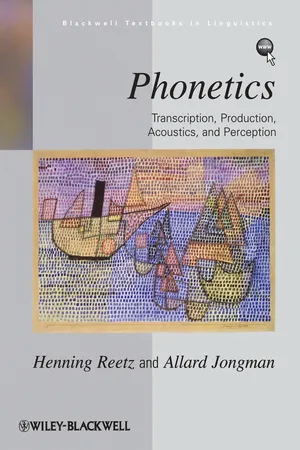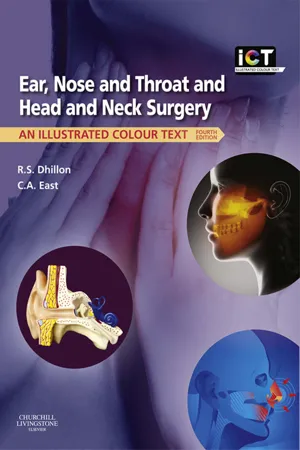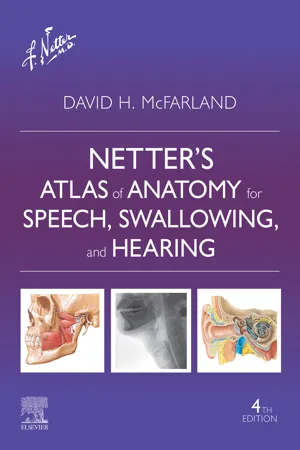Languages & Linguistics
Pharynx
The pharynx is a part of the throat located behind the oral cavity and nasal cavity. In the context of languages and linguistics, the pharynx plays a role in speech production, particularly in certain sounds and articulations. It is involved in the production of sounds such as pharyngeal consonants, which are made by constricting the pharynx.
Written by Perlego with AI-assistance
6 Key excerpts on "Pharynx"
- eBook - ePub
The Speech Chain
The Physics And Biology Of Spoken Language
- Dr. Peter B. Denes, Dr. Elliot N. Pinson(Authors)
- 2016(Publication Date)
- Hauraki Publishing(Publisher)
Much more research has to be done before we can fully explain how the characteristics of the sounds produced depend on the shape of the vocal tract. Even where the process is fairly well understood, complicated mathematics are needed for the calculation of the formants. As a result, much of what we know about the formants of speech sounds is obtained simply by examining the sounds produced when the vocal tract has a given shape, rather than by explaining how these formants came about. Examination of the acoustic characteristics of speech waves has not only produced more information about formants, but has brought to light other important features of speech waves. These results will be described in Chapter 7.Passage contains an image
We have seen how the energy for speech is provided by the air stream from the lungs and how vocal cord vibration generates an audible buzz. Let us go on to see how the quality of this buzz is changed by the configuration of the vocal tract. A cross-sectional view of the vocal tract is shown in Fig. 4.7. The vocal tract extends from the glottis to the lips—by way of the Pharynx and mouth—with a side branch into the nasal passages.The Pharynx is the part of the vocal tract nearest the glottis. It is a tube connecting the larynx with the mouth and the nose. At its lower end, the Pharynx meets the larynx and the esophagus and, at its wider upper end, joins with the back of the mouth and the nose, as shown in Fig. 4.8. We have known for some time that its shape and size are changed when swallowing, either by moving the tongue back, or the larynx up, or by contracting the pharyngeal walls. Only recently, however, has it been noticed that such changes take place during speech. These changes can be seen clearly in the vocal tract outlines shown in Fig. 4.9. Very little is known about the pharyngeal changes we make for distinguishing one speech sound from another. As a result, we shall not have much to say about the Pharynx later in this chapter, when we describe the movements of the vocal organs for articulating English speech sounds.The nasal cavity (see Fig. 4.7), extending from the Pharynx to the nostrils, is about four inches long. It is divided into two sections by the septum , a central partition that runs along the entire length of the cavity. Ridges and folds in the cavity’s walls break up some segments of the nasal air passages into intricately shaped channels. At the back of the nose—and also lower down in the Pharynx—are the tonsils (see Fig. 4.7). They occasionally grow large enough to influence the air flow from the lungs and, when they do, they add the characteristic “adenoidal” quality to the voice. The sensory endings of the nerve concerned with smell are also located in the nose. The nasal cavities can be isolated from the Pharynx and the back of the mouth by raising the soft palate - eBook - ePub
Phonetics
Transcription, Production, Acoustics, and Perception
- Henning Reetz, Allard Jongman(Authors)
- 2011(Publication Date)
- Wiley-Blackwell(Publisher)
2
Articulatory Phonetics
An important component of phonetics is the description of sounds. One mode of description is articulatory; that is, it involves an articulatory description of how speech sounds are produced. First of all, the production of any kind of sound requires a source of energy. For speech this energy source is the flow of air. For most sounds of the world’s languages, this airflow is generated by the lungs, which are described in detail in Section 5.1. Air flows from the lungs through the trachea (windpipe) and then through the larynx (voice box), where the vocal folds are located. The larynx and its role in the complex process of voice formation are discussed in detail in Section 5.2. Finally, the physiological details of the upper part of the speaking apparatus, namely the Pharynx (throat), oral tract (mouth), and nasal tract (nose) are presented in Section 5.3. In this chapter, aspects of the speaking apparatus that are easy to observe will be introduced, including phonation at the larynx and articulation in the vocal tract. This description will help to explain terms used for phonetic transcription (Chapter 3).2.1 Phonation at the Larynx
The larynx (voice box) is located at the bottom of the Pharynx (throat) on top of the trachea (windpipe) and consists of cartilage, muscle, ligament, and tissue. For some speakers, the larynx is visible as the Adam’s apple, moving up and down during swallowing and speaking. It is not this movement that is central for speech production but the operation of two small muscular folds inside the larynx. These are known as the vocal folds (or vocal cords) and airflow generated by the lungs must pass through them. The vocal folds can be either apart, close together, or tightly closed. When they are apart (as in normal breathing), air travels through without much obstruction. When they are tightly closed, no air passes through, which prevents, for example, food from entering the trachea. When they are close together, the airstream from the lungs will make them vibrate. This vibration is known as voicing or phonation. It is important to note that voiced sounds such as vowels and many consonants are produced with vocal fold vibration (vocal folds close together) while voiceless sounds are produced without vocal fold vibration (vocal folds apart). The presence and absence of vocal fold vibration can be determined by placing your finger loosely on your Adam’s apple and prolonging the sound at the beginning of a word likez ip(“zzzzzzzz”). This is a voiced consonant produced with vocal fold vibration and you should be able to feel this vibration with your finger. The beginning of a word like sip - eBook - ePub
The Sounds of Language
An Introduction to Phonetics and Phonology
- Elizabeth C. Zsiga(Author)
- 2012(Publication Date)
- Wiley-Blackwell(Publisher)
- People throughout recorded history have been interested in describing the structure and function of the organs of speech, but this was difficult to do with precision until the advent of tools such as the X-ray, sonography, and MRI that allow us to “see” inside the body. In this chapter we recall the basics of how each technology works, with its strengths and limitations.
- There are no parts of the body used exclusively for speech. All the parts of the vocal tract have another, non-speech use.
- Speech is the movement of air made audible. Air can be made audible by making a narrow turbulent channel, by building up pressure behind a constriction, or by making the body of air resonate.
- The vocal tract can be divided into three sub-sections: sub-laryngeal, laryngeal, and supra-laryngeal.
- Most speech sounds are made with air exiting the lungs: the pulmonic egressive airstream.
- The larynx is made up (in part) of the cricoid cartilage, thyroid cartilage, arytenoid cartilages, and vocal folds. This chapter shows us the approximate shape and position of each. The primary linguistic function of the larynx is the control of vocal fold vibration (pitch and voicing).
- The supralayrngeal tract can be divided into active and passive articulators. The active articulators are the lower lip, tongue front (tip and blade), tongue body, and tongue root. The passive articulators are the upper lip, upper teeth, alveolar ridge, post-alveolar region, hard palate, soft palate (velum), uvula, and pharyngeal wall.
- In addition to its status as a passive articulator, the velum is a valve that opens and closes to regulate airflow between oral and nasal cavities.
Further Reading
Well, you might want to start with the rest of this book. Chapters 2 and 5 in particular have more details on anatomy and physiology, and further in-depth readings are listed at the ends of those chapters.Language Evolution (2003, Oxford: Oxford University Press), edited by Morten Christiansen and Simon Kirby, provides a number of perspectives on the theories and controversies surrounding the evolution of language.A Short History of Linguistics - eBook - ePub
Ear, Nose and Throat and Head and Neck Surgery
Ear, Nose and Throat and Head and Neck Surgery E-Book
- Ram S Dhillon, Charles A. East(Authors)
- 2012(Publication Date)
- Churchill Livingstone(Publisher)
The ThroatAnatomy and physiology
This section will discuss the non-neoplastic diseases of the throat. The regions included in the broad term ‘throat’ are:oral cavityPharynxlarynxmajor salivary glands.Oral cavity
The oral cavity is frequently called the mouth but, in fact, also comprises the anterior two-thirds of the tongue, the lips, hard palate, teeth and alveoli of the mandible and maxilla. Its major function is to provide the milieu for satisfactory mastication.The tongue (Fig. 3.1 ) is a mass of interlacing muscle contained in a bag of cornified squamous epithelium. It contains numerous taste buds and is essential for efficient articulation, mastication and deglutition.Fig. 3.1 Anatomy of the tongue.The teeth provide the mechanics for grinding food and are composed of enamel, dentine and cementum. The primary dentition of 20 teeth is completed by about 3 years. There are 32 teeth in the secondary (permanent) dentition commencing at about 6 years and complete by about 18 years (Fig. 3.2 ). The teeth-bearing alveoli of the maxilla are intimately related to the maxillary sinus. Occasionally the roots of the teeth may rest within the sinus cavity and lead to sinusitis secondary to dental disease.Fig. 3.2 Primary and secondary dentition. In the completed primary dentition, each one-quarter jaw contains five teeth. In the completed secondary dentition, each one-quarter jaw contains eight teeth.As food is masticated it is mixed with saliva and formed into a bolus which is swallowed after the soft palate has occluded the nasoPharynx from the oroPharynx. This is the oral phase of deglutition (first stage) and is voluntary.Pharynx
For clinical purposes the Pharynx is divided into three regions:nasoPharynxoroPharynxhypoPharynx.It stretches from the base of the skull above to the cricopharyngeal sphincter below. The oroPharynx and hypoPharynx, although primarily concerned with swallowing, are so closely related to the laryngeal inlet that pathology in these areas may cause symptoms and signs in adjacent regions. The important clinical structures in each part of the Pharynx are shown in Figure 3.3 - David H. McFarland(Author)
- 2022(Publication Date)
- Elsevier(Publisher)
Chapter 3OROPHARYNGEAL-ARTICULATORY SYSTEM
- Overview, 109
- Cranial Anatomy, 110
- Cranium, 110
- Facial Skeleton, 114
- Sinuses, 118
- Vocal Tract, 119
- Pharyngeal Cavity or Pharynx, 119
- Nasal Cavity, 122
- Oral Cavity, 124
- Tonsils, 126
- Palate, 126
- Tongue, 126
- Salivary Glands, 128
- Lips, 128
- Teeth, 130
- Muscles of the Lips and Facial Expression, 134
- Orbicularis Oris Muscle, 134
- Two Transverse Muscles, 134
- Five Angular Muscles, 136
- Three Vertical Muscles, 138
- Muscle of the Neck, 139
- Platysma Muscle, 139
- Muscles of the Tongue, 140
- Intrinsic Muscles of the Tongue, 140
- Extrinsic Muscles of the Tongue, 142
- Muscles of Mastication, 144
- Temporomandibular Joint, 144
- Three Jaw-Closing Muscles (Jaw Elevators), 146
- Four Jaw-Opening Muscles (Jaw Depressors), 148
- Muscles of the Soft Palate, 152
- Levator Veli Palatini Muscle, 152
- Tensor Veli Palatini Muscle, 152
- Palatoglossus (Glossopalatine) Muscle, 154
- Palatopharyngeus Muscle, 154
- Uvular Muscle (Musculus Uvulae), 154
- Muscles of the Pharynx, 155
- Superior Pharyngeal Constrictor Muscle, 155
- Middle Pharyngeal Constrictor Muscle, 155
- Inferior Pharyngeal Constrictor Muscle, 155
- Salpingopharyngeus Muscle, 157
- Stylopharyngeus Muscle, 157
- Velopharyngeal Mechanism, 157
- Esophagus, 160
- Pharyngoesophageal Segment or UpperEsophageal Sphincter, 160
- Primary Esophageal Peristalsis, 160
- Lower Esophageal Sphincter, 160
- Visualization of Oropharyngeal-Articulatory Structures, 164
■ OVERVIEW
The supralaryngeal vocal tract is crucial for speech sound generation. Its function is to modify the laryngeal sound source to produce the sounds of speech. Vowels are created by changing the configuration of the vocal tract, which acts as a filter with modifiable resonant modes. Frequencies at or near these resonant modes (called formant frequencies- eBook - ePub
- Nigel Hewlett, Janet Mackenzie Beck(Authors)
- 2013(Publication Date)
- Routledge(Publisher)
In some other languages of the world there are, in fact, a few speech sounds that can be produced while holding the breath. This is because airflow within the vocal tract can be initiated by movements of the larynx or the tongue rather than by respiratory effort. Such sounds are relatively rare, however, and are considered in more detail in chapter 6. For the rest of this chapter, it may be assumed that all sounds are produced using a pulmonic egressive airstream. Practice 4.1 Take a breath and count slowly and clearly until you run out of breath. Notice what happens as you begin to run short of air. You will probably become increasingly aware of the way in which pulses of air are actively pushed out of the lungs using a combination of downward and inward movement of the ribs. Note how far you are able to count before you are forced to stop by lack of air. Try the same counting task while breathing in. Note any changes in the quality of your voice. Are you able to count as far on one breath? Phonation A major classificatory distinction in phonetics relates to what is happening as the air stream passes through the larynx. A fuller discussion of this process is given in chapter 18, but the brief description that follows should allow an adequate level of understanding for the early stages of phonetic analysis. The larynx is situated within the neck, just above the top of the trachea. It is a surprisingly complex structure of muscle and other soft tissues within a protective framework of cartilages, and it probably evolved primarily as a mechanism for protecting the airway. The larynx is usually easily located by identifying the thyroid cartilage. This is the largest cartilage of the larynx and forms a protective and supporting girdle around the front of the airway. It can be felt, and often seen, as a protuberance at the midline of the neck. It tends to be more prominent in men than in women, and is hence often known as the Adam’s apple
Index pages curate the most relevant extracts from our library of academic textbooks. They’ve been created using an in-house natural language model (NLM), each adding context and meaning to key research topics.
Explore more topic indexes
Explore more topic indexes
1 of 6
Explore more topic indexes
1 of 4





